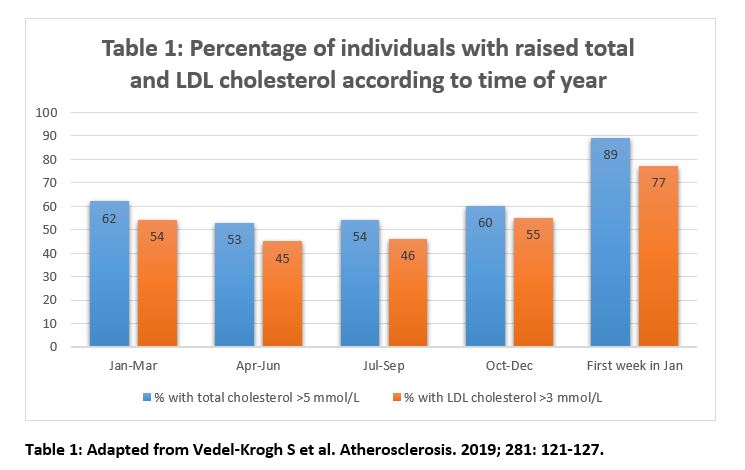Helping patients maintain healthy cholesterol levels in the New Year
January is the perfect time to re-set and aim towards new goals. Whether it’s to try dry January, eat a healthier diet or be more physically active, many of us hope to improve our health as we enter the new year. Keep reading to find out more about the research behind the impacts on cholesterol over the festive period, and our top tips for a happy and healthy 2024.

Whilst the nation is encouraged to ‘Eat, Drink and Be Merry’ during the month of December, a month of indulgence on festive food and drink rich in calories, fat and sugar, can also result in expanding waistlines – with typical weight gains of 0.4-0.9kg (roughly 2lbs) seen over the festive period!1
Festive weight gain & higher cholesterol levels
On Christmas day alone, it is reported that people consume around 6,000 kcals (25,104 kJ)2– three times the recommended daily intake for women and over two times for men.3 However, it’s not just waistlines that suffer.
Indeed, a UK study of 35 individuals, over 30 years ago, both with and without type 2 diabetes, showed that Christmas feasting was associated with both gains in weight (mean 0.8 (SD 0.1) kg, p less than 0.001) and slight but significant increases in cholesterol levels (p less than 0.02) immediately following Christmas.5
In 2019, a cohort study supported these earlier findings that Christmas indulging may lead to increases in total and LDL cholesterol.
For the research, published in the journal Atherosclerosis, scientists looked at mean total and LDL cholesterol levels at different times of the year and included 25,764 Danish adults (average age = 59 years) from the Copenhagen General Population Study, none of whom were taking cholesterol-lowering therapy. The study found that in June, mean total and LDL cholesterol were 5.1 mmol/L and 2.8 mmol/L, respectively. But in those individuals attending the study in the first week of January, mean total and LDL cholesterol levels were higher at 6.2 mmol/L and 3.7 mmol/L respectively.
The incidence of hypercholesterolemia – defined by total cholesterol >5 mmol/L or LDL cholesterol >3mmol – was also higher at the start of the New Year. In the first week of January, 89% had total cholesterol above 5 mmol/L and 77% had LDL cholesterol above 3 mmol/L, compared with 53% and 45%, respectively, in April to June (Table 1). This conveys that compared with individuals attending the study during the rest of the year, those tested in the first week of January were six times as likely to be classified as having hypercholesterolemia (odds ratio 6.0 (95% confidence interval 4.2-8.5).
Table 1: Percentage of individuals with raised total and LDL cholesterol according to time of year

The authors of the study concluded that the Christmas period is associated with higher levels of total and LDL cholesterol and a higher risk of hypercholesterolaemia. The findings provide further evidence for the importance of diet in maintaining healthy cholesterol levels. Healthcare professionals can play an important role in supporting patients by offering cholesterol-lowering diet and lifestyle advice and providing follow-up care up since blood lipids are likely to change over time.
Conclusions
Persistent high cholesterol levels is one of the main risk factors for cardiovascular disease (CVD)6 – so while seasonal increases might not affect cholesterol levels long term, keeping cholesterol levels below recommended targets should be on everyone’s radar all year round to help mitigate the risk of CVD. Therefore, for health professionals providing cholesterol lowering advice to help patients get back on track after Christmas, helping patients to follow a healthy diet should always be the first step and continue alongside any drug therapy.
Our top tips for a healthy 2024
1. Eat breakfast – catching up on sleep New Year celebrations can mean skipping breakfast, which in a recent meta-analysis was found to increase the risk of CVD.7 Instill good habits from the outset and opt for a healthy breakfast such as porridge oats. Did you know beta-glucan found in oats contributes to the maintenance of normal blood cholesterol levels?8
2. Keep an eye on foods high in saturated fat – randomised controlled trials show reducing saturated fat reduces total and LDL cholesterol.9 Patients aiming to lower their saturated fat intake should be advised to reduce their intake of foods such as pastries and pies, meat with visible fat e.g. lamb chops, processed meat, coconut and palm oils, coconut cream and full fat products such as cream. Instead, intakes of fat should mainly come from sources of monounsaturated fatty acids, including essential fatty acids n-6 and n-3 PUFA.6 For example, dietary sources of monounsaturated fats include vegetable oils, olive oil, avocados, nuts and seeds.
3. Encourage activity – 150 minutes of moderate-intensity aerobic physical activity or 75 minutes of vigorous intensity exercise each week.10 Physical activity can help to lower cholesterol and improve good cholesterol – HDL. And you don’t need to be a marathon runner to get the benefits from physical activity, significant improvements in mortality can be seen when an individual goes from being sedentary to moderately active.11 For best results, make sure the activity is enjoyable and personalised.
4. Go more plant-based – plant foods contain vitamins and minerals, dietary fibre, unsaturated fats and phytonutrients, and studies show plant-based eating patterns such as Mediterranean, Nordic, vegetarian and vegan diets can help lower CVD-related risk factors such as LDL cholesterol.13-15 Adding more vegetables to meals and choosing vegetarian meals containing beans, lentils, chickpeas or soya can help increase plant foods, and reduce red meat – one of the main food sources of saturated fat in our diet.16
5. Include products with added plant stanols – plant stanols are added to foods such as yogurt drinks, yogurts, spreads and soft cheese in specified amounts, and a daily intake of 1.5-2.4g of plant stanols has been shown to lower LDL cholesterol by an average of 7-10% in two to three weeks. High cholesterol is a risk factor for coronary heart disease. More than 80 clinical studies and a EU Commission authorised health claim support the safety and cholesterol-lowering effect of plant stanols.12
The EAS/ESC 2019 guidelines6 encourage healthcare professionals to consider plant stanols (phytosterols) as part of the management of elevated cholesterol, especially for the following three patient groups:
- Individuals with high cholesterol levels at intermediate or low global CVD risk who do not qualify for pharmacotherapy
- As an adjunct to pharmacologic therapy in high and very high risk patients who fail to achieve LDL-cholesterol target levels on statins or are statin intolerant
- Adults and children with familial hypercholesterolemia
